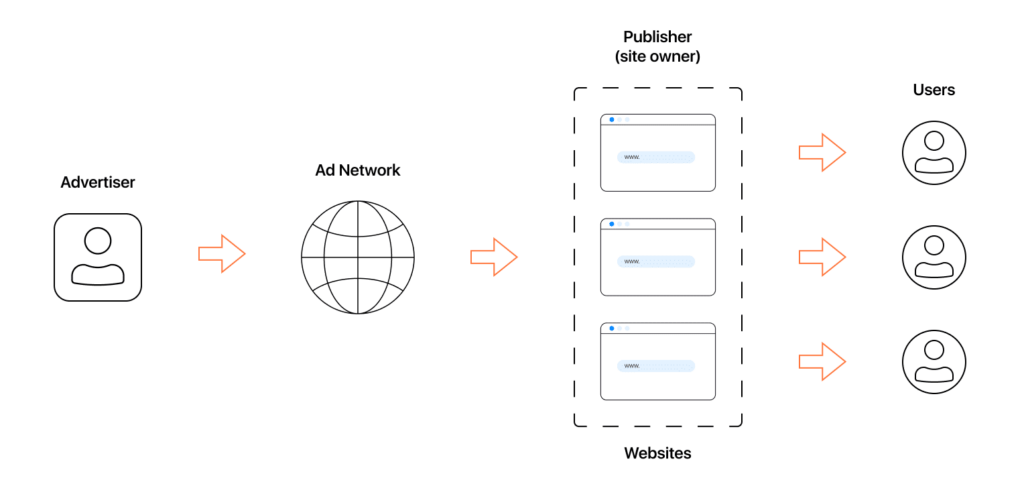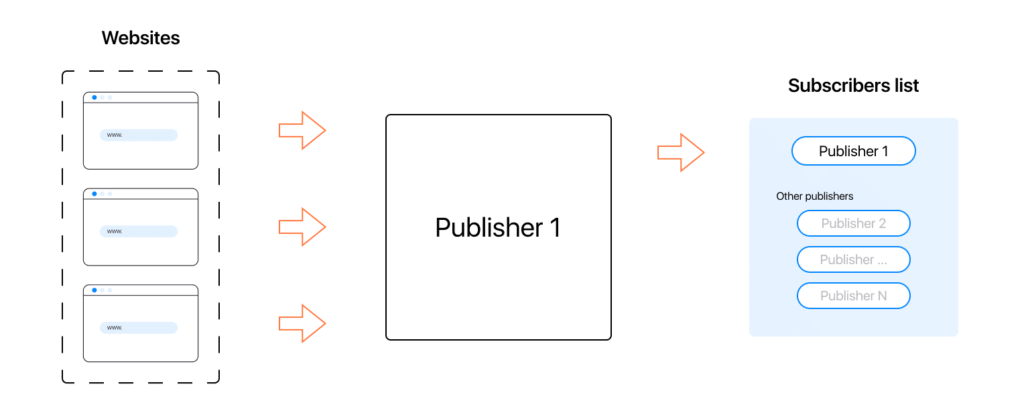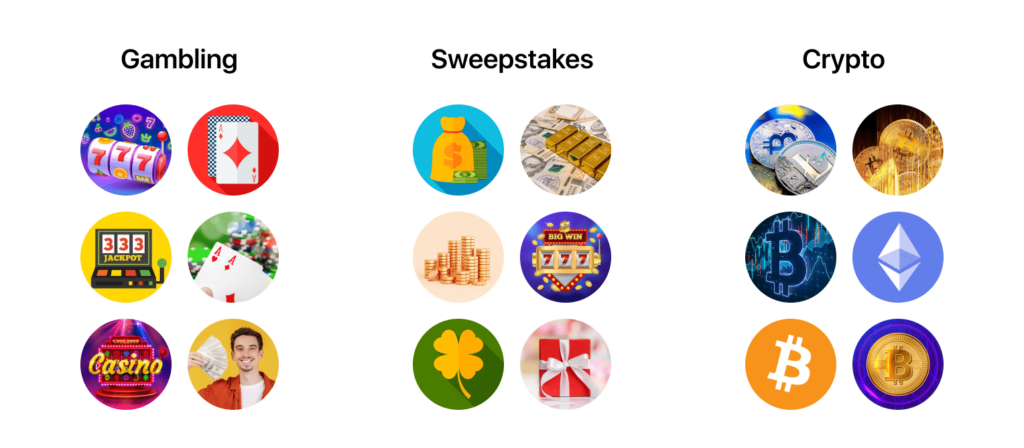In the bustling world of affiliate marketing, staying ahead of the curve with innovative advertising strategies is crucial. One such strategy that has gained significant traction among advertisers is running push ad campaign.
Let’s dive into push ad campaigns meaning, how they work, and why they might be the game-changers you need for your advertising efforts.
A push ad campaign is a digital marketing strategy that utilizes push notifications to deliver promotional messages directly to users’ devices. These notifications can appear on smartphones, tablets, or desktops, even when the user is not actively browsing the internet.
Here’s a concise breakdown of what a push ad campaign involves:
Running push ad campaigns is a useful way to cover a wide variety of verticals. The following verticals tend to have higher click-through and conversion rates than the other ones, which makes them more profitable for marketers.
The list of best verticals for push notifications:
As some verticals, like Adult, Dating, Gambling, and Sweepstakes are prohibited in social networks, running push ads become almost the only appropriate solution for the promotion of such offers. Note that some restrictions may also be related to the laws of a particular country. For example, gambling or betting offers are forbidden for advertising in the United Arab Emirates.
Due to the adaptability of push notifications, it is impossible to say which vertical performs best, but it’s definitely worth focusing on not too-specific offers because of the lack of interest-based targeting.
We’ll explain some technical aspects of push campaigns related to their setup, and then tell you how to get the most out of this knowledge.
The targeting options in both push and social media campaigns are very different. Unlike push campaigns, social networks offer more targeting options based on user personal data: age, gender, and interests. Moreover, users leave the data themselves, creating their personal accounts.
While social media collect personal data, almost nothing is known about the browser users. Everything you can learn about the target audience comes down to device options, browser parameters and geolocations.
Here are 4 conditional targeting categories in push ad campaigns:
Even though push notifications are voluntary, not all users are equally interested in the notifications they subscribe to. Traffic segmentation helps to discover what audience group is the most effective.
Push traffic can be divided into 2 groups, depending on the following factors:
By targeting premium sources, advertisers can maximize campaign results, while sources with standard or low performance can be used for further scaling.
Most of the used cost models in push advertising are CPC and CPM.
Let’s take a closer look at them:
| CPC | CPM |
|---|---|
| Stands for: Cost Per Click | Stand for: Cost Per Mille (1K impressions) |
| Context: Advertisers pay for only user’s clicks | Context: Advertisers pay for every 1K impressions |
| Best for: Generation of conversion-centered campaigns | Best for: Broad audience marketing, in particular increasing brand awareness |
Advertisers often choose the CPC cost model because of knowing how many clicks they can get according to their campaign budget. And on this basis, the CPC model seems to be more simple and less risky, unlike CPM.
The steps we outline below are a basis for any network.
To promote their offers, advertisers need publishers who have their own websites. Publishers or site owners, in turn, are interested in collaboration with advertisers because their purpose is to monetize existing traffic. Obviously, publishers can create an opt-in form for collecting subscriptions through a special plugin, but this way takes much time and reach only website visitors.
The most effective way to monetize or buy traffic is cooperation with push ad agencies that meet the needs of both sides:
Push ads networks aggregate many site owners in one place, giving access to a great amount of traffic for advertisers.

Subscribers lists are the largest traffic source in any ad platform. Each list can include several publishers. And accordingly, each publisher can have either one site or multiple ones.

Setting up push campaigns doesn’t imply as many targeting options as social media advertising accounts have. However, push technology provides large volumes of traffic compared to social networks. If a campaign is launched in some ad platform, there are also more opportunities for affiliates to optimize it. Thus, the success of a campaign depends on its proper setup.
Here, we’ll share the secrets of high-performance-based campaigns.
When choosing GEO, advertisers should consider that each country has its level of economic development, needs, culture and laws – all these factors influence on advertiser’s profit.
As GEOs are categorized in a tier system, you can focus on a particular group:
If you choose GEO from the Tier-1 group, you have a chance to get the largest payouts for offers, but the cost of this traffic will be high. Also, you can profit from the high traffic volumes of Tier-3 countries at a low price. The selection of GEO from the Tier-2 group is an alternative to mentioned options.
Choosing GEO impacts the potential amount of traffic that you can get. Affiliates can cover all countries while creating campaigns, provided that they have enough budget and time for testing and this strategy is appropriate.
Users’ attention is one of the most valuable commodities nowadays so push creatives are designed to attract it. Look at a few tips on how to make eye-catching creatives:

Icon should be simple and coupled with the main image. So, complex graphics or over-detailed icon isn’t the best option.

It is preferable to choose a catchy main image that will convey the sense of the offer. The idea of the image must be clear at the first sight. The best practices for image plots are happy people and before-after pictures;
A successful title is short and meaningful at the same time, as well as the description. The format of push notifications is limited to several words, so start with the most important message of your offer.
Use various creatives for your campaigns and change them from time to time. Even the most ordinary creative can come off. Regular updates ensure your ads stay relevant and continuously capture audience attention.
If an ad network divides all available traffic into groups, offering sources of different performance levels, it’s better to seize this opportunity. By choosing premium sources, it is possible to increase CR and reduce CPA when testing only part of traffic. The rule that works here is: “Quantity does not equal quality”. Sources with lower performance and lists of new subscribers can be used for campaign scaling.
Campaigns should be separated for different devices because mobiles and desktops differ only by traffic features. It is definitely worth doing because separation makes optimization easier. To separate campaigns, you need only duplicate the created campaign and replace device settings. The process of creating separate campaigns for devices may be slightly different for diverse ad networks.
Optimization is the power of push format, and it may have an even greater impact on conversion results when its options are would be used to the fullest. For example, you can set up Automated Rules that allow making changes based on the conditions users choose. If you set rules, all low-converting sources can be blacklisted at once. It’s more convenient than excluding each source one by one manually.
Likewise, you can use other optimization features to achieve the best campaign performance. Ways of optimization are numerous, so use any opportunity to improve your campaign and reach the target audience more precisely. Experimenting with different targeting options, ad scheduling, and bid adjustments can further refine your strategy and enhance results.
In the bustling world of affiliate marketing, staying ahead of the curve with innovative advertising strategies is crucial. One such strategy that has gained significant traction among advertisers is running push ad campaign.
Let’s dive into push ad campaigns meaning, how they work, and why they might be the game-changers you need for your advertising efforts.
A push ad campaign is a digital marketing strategy that utilizes push notifications to deliver promotional messages directly to users’ devices. These notifications can appear on smartphones, tablets, or desktops, even when the user is not actively browsing the internet.
Here’s a concise breakdown of what a push ad campaign involves:
Running push ad campaigns is a useful way to cover a wide variety of verticals. The following verticals tend to have higher click-through and conversion rates than the other ones, which makes them more profitable for marketers.
The list of best verticals for push notifications:
As some verticals, like Adult, Dating, Gambling, and Sweepstakes are prohibited in social networks, running push ads become almost the only appropriate solution for the promotion of such offers. Note that some restrictions may also be related to the laws of a particular country. For example, gambling or betting offers are forbidden for advertising in the United Arab Emirates.
Due to the adaptability of push notifications, it is impossible to say which vertical performs best, but it’s definitely worth focusing on not too-specific offers because of the lack of interest-based targeting.
We’ll explain some technical aspects of push campaigns related to their setup, and then tell you how to get the most out of this knowledge.
The targeting options in both push and social media campaigns are very different. Unlike push campaigns, social networks offer more targeting options based on user personal data: age, gender, and interests. Moreover, users leave the data themselves, creating their personal accounts.
While social media collect personal data, almost nothing is known about the browser users. Everything you can learn about the target audience comes down to device options, browser parameters and geolocations.
Here are 4 conditional targeting categories in push ad campaigns:
Even though push notifications are voluntary, not all users are equally interested in the notifications they subscribe to. Traffic segmentation helps to discover what audience group is the most effective.
Push traffic can be divided into 2 groups, depending on the following factors:
By targeting premium sources, advertisers can maximize campaign results, while sources with standard or low performance can be used for further scaling.
Most of the used cost models in push advertising are CPC and CPM.
Let’s take a closer look at them:
| CPC | CPM |
|---|---|
| Stands for: Cost Per Click | Stand for: Cost Per Mille (1K impressions) |
| Context: Advertisers pay for only user’s clicks | Context: Advertisers pay for every 1K impressions |
| Best for: Generation of conversion-centered campaigns | Best for: Broad audience marketing, in particular increasing brand awareness |
Advertisers often choose the CPC cost model because of knowing how many clicks they can get according to their campaign budget. And on this basis, the CPC model seems to be more simple and less risky, unlike CPM.
The steps we outline below are a basis for any network.
To promote their offers, advertisers need publishers who have their own websites. Publishers or site owners, in turn, are interested in collaboration with advertisers because their purpose is to monetize existing traffic. Obviously, publishers can create an opt-in form for collecting subscriptions through a special plugin, but this way takes much time and reach only website visitors.
The most effective way to monetize or buy traffic is cooperation with push ad agencies that meet the needs of both sides:
Push ads networks aggregate many site owners in one place, giving access to a great amount of traffic for advertisers.

Subscribers lists are the largest traffic source in any ad platform. Each list can include several publishers. And accordingly, each publisher can have either one site or multiple ones.

Setting up push campaigns doesn’t imply as many targeting options as social media advertising accounts have. However, push technology provides large volumes of traffic compared to social networks. If a campaign is launched in some ad platform, there are also more opportunities for affiliates to optimize it. Thus, the success of a campaign depends on its proper setup.
Here, we’ll share the secrets of high-performance-based campaigns.
When choosing GEO, advertisers should consider that each country has its level of economic development, needs, culture and laws – all these factors influence on advertiser’s profit.
As GEOs are categorized in a tier system, you can focus on a particular group:
If you choose GEO from the Tier-1 group, you have a chance to get the largest payouts for offers, but the cost of this traffic will be high. Also, you can profit from the high traffic volumes of Tier-3 countries at a low price. The selection of GEO from the Tier-2 group is an alternative to mentioned options.
Choosing GEO impacts the potential amount of traffic that you can get. Affiliates can cover all countries while creating campaigns, provided that they have enough budget and time for testing and this strategy is appropriate.
Users’ attention is one of the most valuable commodities nowadays so push creatives are designed to attract it. Look at a few tips on how to make eye-catching creatives:

Icon should be simple and coupled with the main image. So, complex graphics or over-detailed icon isn’t the best option.

It is preferable to choose a catchy main image that will convey the sense of the offer. The idea of the image must be clear at the first sight. The best practices for image plots are happy people and before-after pictures;
A successful title is short and meaningful at the same time, as well as the description. The format of push notifications is limited to several words, so start with the most important message of your offer.
Use various creatives for your campaigns and change them from time to time. Even the most ordinary creative can come off. Regular updates ensure your ads stay relevant and continuously capture audience attention.
If an ad network divides all available traffic into groups, offering sources of different performance levels, it’s better to seize this opportunity. By choosing premium sources, it is possible to increase CR and reduce CPA when testing only part of traffic. The rule that works here is: “Quantity does not equal quality”. Sources with lower performance and lists of new subscribers can be used for campaign scaling.
Campaigns should be separated for different devices because mobiles and desktops differ only by traffic features. It is definitely worth doing because separation makes optimization easier. To separate campaigns, you need only duplicate the created campaign and replace device settings. The process of creating separate campaigns for devices may be slightly different for diverse ad networks.
Optimization is the power of push format, and it may have an even greater impact on conversion results when its options are would be used to the fullest. For example, you can set up Automated Rules that allow making changes based on the conditions users choose. If you set rules, all low-converting sources can be blacklisted at once. It’s more convenient than excluding each source one by one manually.
Likewise, you can use other optimization features to achieve the best campaign performance. Ways of optimization are numerous, so use any opportunity to improve your campaign and reach the target audience more precisely. Experimenting with different targeting options, ad scheduling, and bid adjustments can further refine your strategy and enhance results.